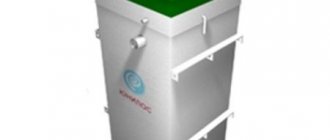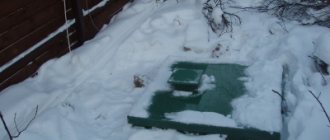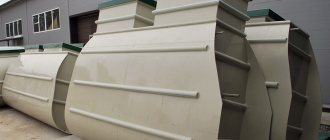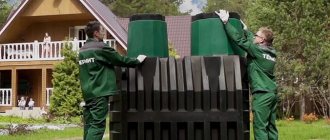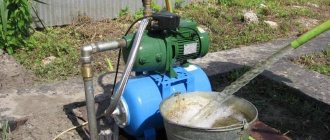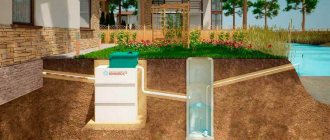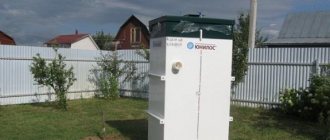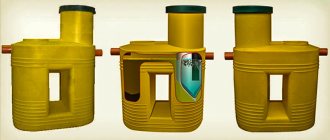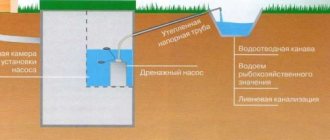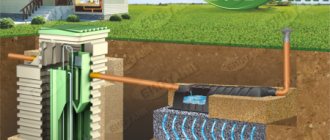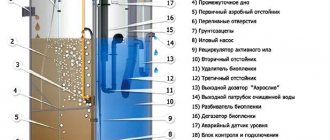Before you begin installing a sewer system in your dacha, you need to decide what exactly the drainage and filtration scheme will be. There are several technical points that should be present in every system:
- The distance from the receiving well to the water wells must be in accordance with SNiP.
- The diameter of the pipeline through which sewage will be drained must correspond to the number of plumbing fixtures and the approximate efficiency.
- The depth of the external trench cannot be higher than the soil freezing layer.
- It is necessary to have a sealed well or septic tank for drainage.
Types of devices for a country house
- Filtration septic tank with a compartment for settling the thick fraction. This is an advanced technology, the main operating principle of which is to separate sewage that enters the collector and divide it into fractions. As a result of passing through several filtration chambers, the liquid is purified to a state that is safe from the point of view of sanitary standards.
- Local treatment plant. In fact, these are mini-purification plants based on the use of bacteria to purify water.
- Using the container as a cesspool.
Country drainage can be separate and common
The first case is when wastewater from different plumbing fixtures enters different containers for sedimentation and filtration. In addition, separate delivery of water from street storm water collectors and the internal network is considered a separate form.
The general sewage collection and drainage system consists of laying a single pipeline both for indoor appliances and for collecting water outside.
Year-round accommodation and summer
If no one lives at the dacha in winter, then it is enough to assemble a summer sewage system. In this case, there is no need to dig a deep trench and lay a larger diameter pipeline.
The outlet from the house also does not need to be installed at the very bottom of the foundation. The exit is made directly from the top point of the plumbing fixture. A simple scheme for collecting summer sewage in the photo:
As for the collector into which the water will be drained, it must still be sealed and securely installed. There is no need to install a septic tank; a regular drainage pit will do just fine. At the end of the summer season, it will simply have to be pumped out and preserved for the winter.
If you live year-round in a private house, you will have to complicate the task a little. To use water and a toilet in cold weather, it is necessary to ensure good insulation of external sewer pipes. In addition, there are still some difficulties during installation. This includes the depth to which the external sections of the water supply system are buried, its insulation, and many other factors.
Components of country sewerage
However, if a city dweller thinks little about installing a sewer network outside his apartment, then when installing a sewer system in a dacha, he has to deal not only with plumbing fixtures and internal communications, but also remember about all the components of the system:
- About plumbing fixtures, risers and pipes inside the building that make up the internal sewerage system;
- About the pipe system located outside the house;
- About places of settling or purification of all waste leaving the house and collected from the site.
And if the internal system is similar to that in apartments, then the remaining two parts of the country sewer system differ significantly from the components of the central city sewer system and can be implemented using different methods.
Norms for the distance of treatment facilities on the site
According to SNiP, treatment facilities and pits must be located at a considerable distance from the house, water well and other engineering facilities.
- From a residential building - at least 5 m to a septic tank, VOC, cesspool to avoid unpleasant odors entering the room. And also prevent in advance the possible disastrous consequences of the influence of a humid environment on the foundation of the house.
- It is 30-50 m to a water well. Of course, it is very difficult to follow this rule, since the size of the plots is very limited. It is still necessary to remove the septic tank from the water supply system as much as possible, to the extent technically possible.
- To the borders of the neighboring plot - at least 2 m.
- From the collector to plants and trees - the location is 2-4 m if the tree roots are large.
Materials and tools
- To dig a trench, you will need a small excavator. If there is no possibility of heavy equipment coming in, you will have to take up shovels.
- The pipes need to be cut with something, some people use a grinder with adjustable speed, or you can use a hacksaw with fine teeth.
- Jackhammer, perforator - make holes in the well and foundation of the house.
- Sand or fine ASG for fixing the pipeline in the trench.
- Insulation, thermal insulation in places where laying sewerage through an external network to a depth below the soil freezing layer is impossible.
The main segment of the drainage system is the pipe, here are its main options:
- Red PVC is available in various sizes.
- Black polyethylene ones also come in diameters from 50 to 159 mm.
- Ribbed - pragma. The length is 4 and 6 m, the diameter is from 100 mm to 500 mm.
- Gray polypropylene (plastic).
Do-it-yourself system installation in a private house
After the cesspool is placed on the site, you can begin to dig a trench to the required depth. In the central part of Russia it is 2-2.5 meters, in the northern regions it is a meter more, and in the southern regions it is 1-1.5 meters. They begin to dig a trench from the wastewater intake point to the top, towards the house.
Now a fine sand and gravel mixture, a “cushion,” is poured onto the bottom of the pit along its entire length. It’s better to immediately “shoot” the slope at least a little and level the sand.
The next step will be laying the pipeline itself. First, the end is inserted into the well so that the socket faces towards the house. It is advisable to immediately secure the pipe in the hole with mortar or foam. Then they are connected in series with the blank end into a socket. To simplify the process, the rubber bands are lubricated with motor oil or special lubricant.
Each pipe is measured to ensure it meets the required slope. This can be done with a building level, but it is better to take a level.
According to SNiP, sewerage is laid along a slope corresponding to the diameter of the pipe. For a diameter of 40-50 mm, the roll is 3 cm per meter, 85-100 mm - 2 cm per 1 m, and for 150 mm it will be 0.8 cm per 1 m.
After assembling the outer line, the line is aligned along its entire length so that the entire straight section is visible through the hole.
Sewage system made of concrete rings
A septic tank is made from concrete rings if the finished plastic tank does not fit in size. It will be easier to do construction work together, so it’s worth calling an assistant.
Advantages and disadvantages of the system
The advantages of the system include the fact that concrete rings are cheap and can be purchased by the general population. During construction, no drawing is required; you do not have to contact a specialized company.
But there are also disadvantages. For example, no matter how hard you try, you won’t be able to make the septic tank airtight, so unpleasant odors will be felt near it. You will also have to periodically hire vacuum cleaners to pump out the accumulated waste.
Scheme and calculations
An example of a septic tank layout at a summer cottage.
A septic tank is made of several rings, they are installed on top of each other. The treatment scheme may include 1 or 2 chambers. For a summer residence, you can choose a simple option from a sump, which is supplemented with a well for filtration.
When performing calculations, SNiP is taken into account. Based on the number of people living in the house, determine the required volume of the sump. It should be able to accommodate waste waste for 3 days.
Preparatory processes
Before installing concrete rings, a pit is dug. A septic tank and a well for filtration must fit freely into it. Sand is poured into the bottom of the hole and compacted. The result should be a pillow with a thickness of 30 to 50 cm.
The bottom of the pit is concreted. If this is not possible, you can purchase 1 concrete ring with a solid bottom. During installation, it is placed first on a sand bed.
Installation of rings
To install reinforced concrete rings you will need special equipment. They are fixed together with staples; instead of them, metal plates can also be used. Additionally, all parts are fastened together with concrete mortar.
After installation is completed, an overflow is made, and sewer pipes are connected to the concrete rings.
Sealing
To make reliable waterproofing, the solution must have a water barrier. The outside of the collector is covered with coating materials, but they can be replaced with built-up materials.
Plastic cylinders can be placed inside the concrete rings. This will reduce the likelihood of leakage to a minimum.
Installation of septic tank rings using special equipment.
Installation of floors and backfilling
The reinforced concrete rings are covered on top with a concrete slab in which a hole is made for a sewer hatch. Fill the septic tank with soil mixed with sand. When the work is completed, the sewer can be put into operation.
How to make proper sewerage when the groundwater level is high
If, when digging a trench, water has already appeared in the upper parts, you will still have to dig to the required depth.
If the sewage system is assembled correctly, groundwater will not affect further work. To prevent water from interfering when laying pipes, the trench needs to be dug a little wider and a recess of 20–30 centimeters must be dug along its very bottom along the edge along the entire length. Liquid will accumulate in this groove, and the ditch will remain dry.
Since the cesspool, VOC, septic tank and drainage system are sealed, high groundwater levels should not affect the treatment process. However, if a VOC or septic tank is installed at the dacha, then a waste pipe or dry well is required, through which water can penetrate back into the septic tank. To avoid this, a check valve is installed on the discharge pipe.
The principle of operation of a septic tank
The operating principle of a septic tank is based on the decomposition of various microbial cultures and the removal of colloidal and dissolved organic substances from domestic wastewater.
The activity of the microflora of the septic tank affects the degree of treatment of household wastewater, the operation of the installation, as well as the absence or presence of odors during the processes. The most important factors influencing the activity of microorganisms are:
- presence of organic matter in household waste;
- temperature of domestic waste (optimally 10-35°C);
- access to oxygen installation;
- effluent acidity value;
- absence of toxic substances.
The septic tank cleans household wastewater both with the use of bioenzymes and without the use of these drugs. The use of bioenzymes allows one to sufficiently accelerate the processes of decomposition of organic substances and increase the quality of wastewater treatment.
Internal layout
Details about the main stages:
- First you need to decide where and what devices will be installed. Depending on their number and purpose, the diameter of the sewer pipe is selected.
- Internal highway markings. The direction of the thread is marked along the wall or floor from the lowest point to the highest. Measurements of pieces for assembly are taken.
- Before starting to assemble, brackets are installed into which the pipes will then be inserted.
- Directly assembling the pipeline by connecting them to each other with a single end into a socket. Before inserting them, the rubber bands are generously lubricated with engine oil. During assembly, it is advisable to use a 45-degree bend rather than a 90-degree bend, since the angle of rotation of the former is much softer. Straight and oblique tees are used to connect devices. It should be remembered that the sewer pipe is not static: it sometimes narrows, sometimes it expands. Therefore, a compensator must be installed in the vertical section. Also, every 5 meters at problem areas and turns it is necessary to lay cleaning inspections. These are special fittings with a screw-on lid through which blockages can be cleared.
- A prerequisite for reliable operation of the drain is to check it after installation. You can check the joints by flushing the entire system. Having assembled all the elbows and tees, insert a hose into the latter and supply water under slight pressure. If everything is done correctly, the joints will remain dry, and all the water will go to the outer part of the line (drain).
Important: the slope of the internal sewerage system is slightly greater than that of the external one. For a pipe with a diameter of 50 mm it is 3 cm per meter, and for 100 mm it is 1.5-2 cm.
Work on the installation of internal sewerage
Work on sewerage installation begins after creating a drawing and purchasing materials. First, install the central riser. Cast iron pipes or PVC or ceramic products are suitable for this purpose; their diameter should be about 110 mm. To ensure good traction, the riser is placed in the attic or raised above the roof.
PVC products have an affordable price. They are not afraid of corrosion and do not overgrow from the inside. The smooth interior ensures free movement of waste. Cast iron is a reliable and durable material, but the pipeline made from it is heavy and difficult to install.
The cost of such products is much higher than the cost of plastic. Ceramic risers occupy a leading position in their characteristics, but are expensive.
The main riser is installed at a distance of 4 m from the windows, after which the pipeline is routed horizontally. There is no need to suddenly change its direction, this makes it difficult for wastewater to move. If you need to rotate it 90 degrees, it is better to rotate it 2 times by 45 degrees. A hole is left in advance in the foundation of the house for it. The sink and bathtub are connected to the sewer using a tube with a diameter of 50 mm.
The common pipeline is made at an angle, this ensures the movement of water in the desired direction. A check valve is mounted at the outlet; it prevents waste from flowing back.
Some tips from the professionals
In order for the sewer system in a private house to work for its intended period, you must first install it correctly. This is 80 percent of success. But even after startup, it is necessary to properly monitor the system.
- Initially, correctly organize and calculate the volume of waste.
- Pump out the cesspool in a timely manner. And not only the liquid fraction, but also the sediment at the bottom of the wells.
- Make sure that no foreign objects get into the pipe that could cause a blockage. For example, small parts of children's toys, rags, etc.
- Conduct a timely external inspection of septic tanks and pits to check their tightness.
Types of sewage systems in the country
Modern technologies offer a lot of ready-made solutions. Depending on your capabilities, needs or other considerations, you can choose the most suitable option for yourself. Usually the main criterion is the frequency of appearance of hosts on the site. In addition, the size of the house, the number of proposed drainage points and other features become an important factor. You should weigh your financial and technical capabilities and choose the most convenient type of sewage system so as not to find yourself in the unpleasant position of an “eternal builder.” In total, there are 5 options for arranging sewerage on the site, which should be studied more carefully:
Dry toilet
This simple method of solving the problem cannot be considered quite successful. Rather, it is a temporary measure, since the problem is only partially solved. The question remains regarding the disposal of wastewater coming from the kitchen or bathroom. Therefore, a dry closet is a portable option that allows you to get out of the situation before the launch of a full-fledged system.
Traditional pit cesspool
Installing a sewer system in a country house using a cesspool is one of the oldest, but quite effective options. The main advantage of this method is its simplicity, low cost and high speed of creation. It is not difficult to build a cesspool; usually, you dig a hole into which 2-3 concrete rings are lowered, and fill the cavity with soil. A sewer pipe is removed into the resulting container, and a lid is installed on top. Periodically (1-2 times a year) a sewage disposal truck is called in to carry out cleaning. Main disadvantages:
- you have to limit yourself in the volume of water flow;
- an unpleasant odor is always present nearby.
These shortcomings have become the main reason for the decline in the popularity of cesspools and the transition of most homeowners to more technological methods.
Storage capacity
The storage tank is a more advanced version of the cesspool. This is a sealed tank (barrel, or other structure), the volume of which can range from 2 to 100 m3. It must be buried in the ground, leaving only a hermetically sealed neck on the surface for regular cleaning procedures. In this case, there are some advantages:
Storage capacity
- no bad smell;
- it becomes possible to connect storm sewer;
- drainage does not penetrate into the ground and does not poison the soil on the site.
The disadvantage of the storage tank is the need to organize frequent cleaning (once a month), the amount of water drained into the sewer will have to be strictly dosed. The best option for using this option is a small country house in which there is no water supply at all, or there is a summer water supply that does not allow for large water consumption.
Construction of a septic tank
A septic tank is one of the most effective and affordable ways to build a sewer system in a country house with your own hands. The structure is a sewer collector, divided into several sections (2-4), connected by overflow pipes. The principle of operation of a septic tank is based on settling, gradual filling of one section, overflow of clarified wastewater into the next - and so on. The last section is a filtration well, into which clarified waste flows and is absorbed into the soil through a layer of sand and crushed stone laid at the bottom. As an option, an infiltrator is installed - a horizontal pipe with holes into which clarified wastewater flows from the last section of the septic tank.
Septic tank
Local sewerage for a dacha, implemented on the basis of a septic tank, allows you to create a complete drainage system that can satisfy all the needs of the residents of the house. Its advantages:
- a modern and environmentally friendly method of waste disposal;
- no periodic pumping required;
- no need to connect power supply;
- there is no specific smell;
- harmful components do not penetrate into the soil;
- you have the opportunity to choose a suitable ready-made system or create it yourself.
We must not forget about the disadvantages:
- the infiltrator and drainage field (the area for releasing treated wastewater into the ground), as well as the collector itself, require a certain area, which is not always possible for small garden plots;
- overloading the system causes an unpleasant odor;
- Periodic cleaning of the collector and other system elements is necessary.
Despite some disadvantages, an autonomous sewage system in a country house, built with your own hands like a septic tank, gives maximum effect with minimal financial investment.
Biological treatment station
For the most complete disposal of solid settled organic waste, a modernized version of the septic tank design is used - a biological treatment station. It has a more complex composition and uses special equipment that requires a power supply. At the same time, this method allows you to obtain the most effective sewage system for drains from the kitchen and washbasin, capable of processing fats and other complex organic compounds.
Biological treatment station
The principle of operation is based on the use of special bacteria that feed on settled waste. There are different types:
- anaerobic bacteria . They do not require oxygen to live. They live in sections of the collector, absorb settled solid waste, releasing methane. Wastewater treatment occurs at 60-70%, so additional treatment is needed on the drainage field;
- aerobic _ They live and function only in an oxygen atmosphere. For them, it is necessary to install aeration tanks and use compressors that supply air to the collector section. At the same time, aerobic bacteria do not emit methane, so there is no smell left behind, and the sludge processed by them can be used as garden fertilizer.
It must be taken into account that creating a full-fledged biological treatment station on the site is a labor-intensive and costly undertaking. It is necessary to carry out a large amount of excavation work, purchase containers, equipment, properly carry out installation and other commissioning work. As a rule, owners of private (and even more so country houses) make do with cheaper and simpler options for installing an autonomous sewer system:
Characteristics and basics of station installation
